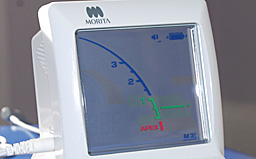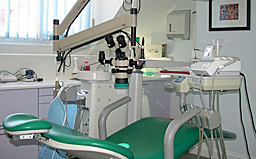What is root canal treatment?
 The purpose of root canal treatment is to remove the inflamed tissue or bacteria inside the root canal and thus allow the surrounding tissues to heal
The purpose of root canal treatment is to remove the inflamed tissue or bacteria inside the root canal and thus allow the surrounding tissues to heal[click to enlarge]
Root canal treatment is carried out when the pulp (soft tissue inside a tooth) is either inflamed or dead. The pulp is a tissue made up of nerves, connective tissue and blood vessels.
The pulp may become inflamed or may die if either there is significant decay in a tooth, if there is a large restoration (filling or crown) or if the tooth has been subjected to trauma.
The inflamed pulp may cause toothache or remain pain-free. When the pulp dies, the space it inhabits (the root canal) rapidly becomes infected with bacteria. This may cause pain and swelling in the supporting tissues (abscess) or the tooth may remain symptom-free.
How root canal treatment can help
The purpose of root canal treatment is to remove the inflamed tissue or bacteria inside the root canal and thus allow the surrounding tissues to heal.
After cleaning the root canal system, the space created is filled with a root filling to prevent reinfection. A material called gutta percha is used as the root filling material. This a natural substance very similar to rubber.
A complex system

 The purpose of root canal treatment is to remove the inflamed tissue or bacteria inside the root canal and thus allow the surrounding tissues to heal
The purpose of root canal treatment is to remove the inflamed tissue or bacteria inside the root canal and thus allow the surrounding tissues to heal[click to enlarge]
The root canal system, especially in molars, is often complex and difficult to clean well. This is why many general dentists prefer to refer these cases to a specialist who has the training, equipment and experience to deal with them well. A specialist will use a surgical microscope during treatment, to magnify the tooth to approximately x20, to enhance success rates.
The treatment is time consuming because of its complexity but can readily be done using modern local anaesthetic techniques with little or no discomfort. It is normal for patients to experience some soreness after treatment as the supporting tissues of the tooth may be a little bruised.
Currently, we can expect success rates of over 90% for first time root canal treatments performed by a specialist endodontist. The success rate is reduced to about 80% when an existing root treatment needs redoing if it has failed. As yet, there are no long term scientific data to tell us how long a root treatment will last although long term failure does not appear to be a problem clinically.
-
What is an Endodontist?
An endodontist is a dental surgeon who specialises in treating endodontic problems (endo-within, dontic-tooth). In general, this involves root canal treatment. In general he/she will have undertaken specialist training.
[ Learn more about Endodontics ]
-
Helpful Links


